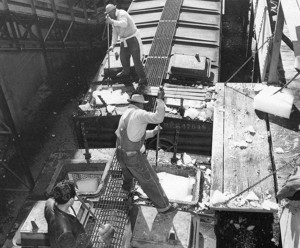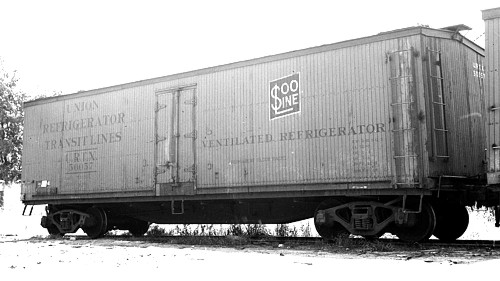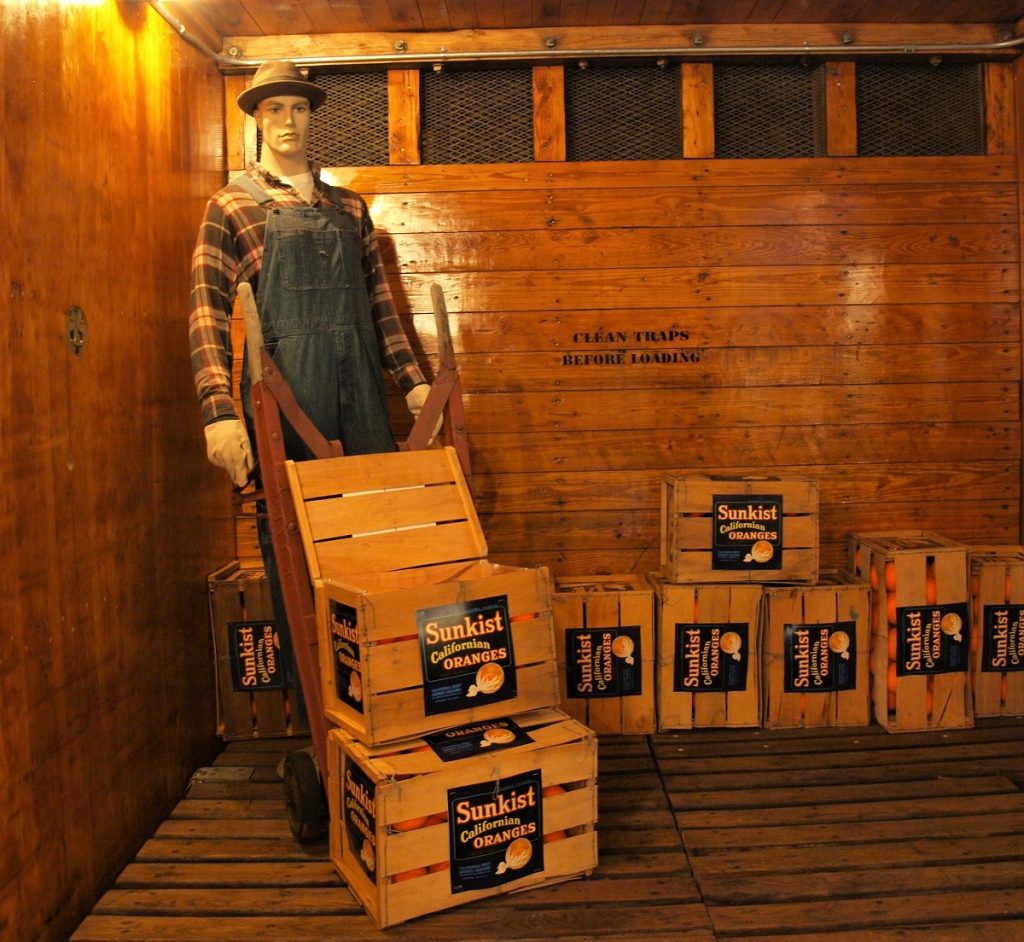
Union Refrigerator Transit Lines Ventilated Refrigerator Car NO. 50056

Behind every meal we eat there is a story of transportation. Imagine long strings of railroad refrigerator cars moving east from the Pacific Coast and north from Florida and the Gulf Coast, carrying fresh lettuce, grapes, vegetables, ripe oranges, grapefruit and peaches. From the heartland of America comes the bacon, ham and sausage processed at huge packing plants. Also traveling the rails is cereal, cream, butter, salt, pepper, sugar, and the grain from which bread is made. These are the products of the American Farmer, and they are just some of the items that make up the vast carloads of perishable commodities which move by rail each year and are transported daily to markets across the country.


The Railroad Refrigerator Car makes the transport of perishables possible. Prior to the development of these specialty freight cars, fresh fruit and vegetables were marketed only in or near the area of production. Supplies of fresh foods was very limited. Many people in the northern two-thirds of the country had never eaten an orange, or had even seen one. Vegetables came packed in cans, if at all, lacking any flavor or freshness. Lettuce salads, so common today, were an unimagined delight.


Known as “reefers”, these cars originated in the 1840’s with the first use of ice in transporting milk and butter, as well as other perishable goods. Early reefers were of all wood construction and were usually 36 feet long. A refrigerator car of the late-1800’s could only travel about 250 to 400 miles before it would need re-icing. Railroads built massive icing platforms and naturally-harvested their own ice at company-owned ice ponds and lakes. Ice was held in huge insulated storage houses at major terminals and other locations in order to quickly service the cars. In later years ice was artificially manufactured right at the icing stations.





Ice-bunker reefers were the mainstay of the refrigerator car fleet through the 1960’s. Simple to maintain, the cars employed no mechanical devices that could break down. Ice bunkers were built into each end of the car and manually filled through hatches on the car roof. Salt was typically placed in the bunkers to enhance the melting of the ice and lower the overall interior temperature of the car. Following an initial icing, cars would be re-iced at roof-level platforms while in transit. The disadvantage was that, although the cars were easy to manage, they required a tremendous amount of ice. It took 9,000 to 11,000 pounds of ice to fill a car’s bunkers, and each car on a transcontinental trip would require several stops to be re-iced. That, as well as the manual labor involved (each single block of ice could weigh as much as 400 pounds), the cost of making ice, and the numerous stops, contributed to the cars’ downfall.





Mechanical refrigerator cars of steel construction began appearing in large numbers in the 1950’s for carrying frozen foods and produce. The new mechanical reefers marked the end of the “ice age”. Most icing platforms had been removed by 1970, although many old, wood-bodied ice cars (like the Museum’s URT No. 50056) remained in “top-ice” service, in which crushed ice was applied on top of the commodity itself when loaded.

The Museum’s ice-bunker reefer is a 36-ton capacity car, built by American Car & Foundry (ACF) at its St. Louis plant for the Union Refrigerator Transit Lines (URT), circa 1928-1930.
Unfortunately, very little information is available on the origins of URT. Research suggests that it originally may have been formed in 1895 as the Union Refrigerator Transit Company of Milwaukee, Wisconsin by the Joseph Schlitz Brewing Company to own and operate a line of refrigerated railroad cars. Another source shows that URT was incorporated in 1903, with no indication that the company was ever started by, or was involved with the Schlitz Brewing Company. There was a Schlitz Refrigerator Transit Co., but apparently it was always separate from URT. In 1929 URT was acquired by General American Tank Car Corporation, one of the largest companies to build and lease specialty cars to railroads. In the early 1970s General American, by then known as General American Transportation Company (GATX) phased its URT subsidiary out of existence and divested itself of the aging wooden fleet of former Union Refrigerator Transit reefers. From that point on, the URTX reporting marks disappeared forever from the American railroad scene.


ACF built large numbers of wooden reefers for URT during the 1920’s.The Museum’s car was one of many under lease to the Minneapolis, Saint Paul & Sault Saint Marie Railway. Originally painted bright yellow with red-oxide ends and roof, the car carried the famous herald of the Soo Line throughout it’s more than 4-decades of active service. After a late-1940’s rebuilding which featured new, steel ends that replaced the original wooden ends, the car was painted orange with black roof and ends.




Removed from service in 1972 by General American Transportation Corporation, the car found it’s way to Whippany, and later Morristown, NJ where it was used for many years as a storage unit by the Morristown & Erie Railway. In July 2005, the car became part of the Whippany Railway Museum’s Rolling Stock Collection. No. 50056 is quite a rare piece of railroad rolling stock in the 21st Century. It is amazing that it still retains it’s four original roof-mounted ice hatches, as well as the original ice-bunkers at each end of the car. Even the outside drain pipes are still in place and functional. The wooden floor racks are still in place in working condition, as they can be lifted out of the way and secured to the well-insulated interior walls, as originally intended.

Unfortunately, the wooden exterior of the car needed extensive work. The Museum began a rehabilitation of the exterior in Spring 2007, as the photos show. All exterior wood was removed and replaced with new.



Museum volunteers worked long, hard hours to complete this exterior restoration, and by Fall 2007, the first coat of “Reefer Yellow” was hand-applied to the new wood, instantly turning back the pages of time. By Fall 2008, for the first time since the late-1940’s, the old reefer was again proudly showing off it’s, historic Union Refrigerator Transit Lines lettering.

The Museum’s plan for the interior of the car was to restore it and open it to the public, allowing visitors to examine the ice bunkers and view exhibits which would help tell the story of how perishable commodities traveled to market in the first half of the 20th Century.

The first task was to remove decades of patching material, grime and varnish to get down to the bare wood.


Because puddles of water from the melting ice were a common occurance, a removable, slatted wooden floor was installed in these cars to provide a dry surface for those working in them. Museum volunteers cleaned, sanded, refinished and reinstalled these panels.





With the interior finished, the final task was to create a display which would help visitors learn about this part of railroad history. Both cabinets which help explain why and how these cars were used as well as a representation of a worker and cargo were installed.

Our Ventilated Refrigeratior Car is also home to the Erie Railroad Light-Up Display. While we don’t have the complete information about this artifact, it appears it was created by the Erie Marketing Department circa 1951, which was the year the railroad celebrated its 100th Anniversay. Prospective customers could see major Northeastern cities lit to demonstrate how advantageous shipping their products via the Erie could be.

Special thanks goes to Don Ginter of the Mid-Continent Railway Museum in North Freedom, Wisconsin for his research and input on Union Refrigerator Transit Lines refrigerator cars.